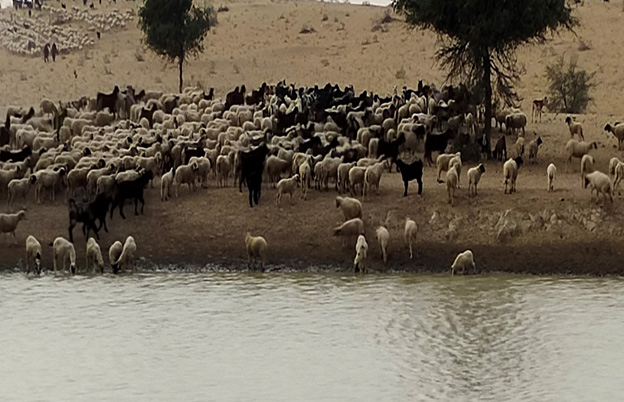Regional Office, Bahawalpur
Regional Office Bahawalpur
The Pakistan Council of Research in Water Resources (PCRWR) established its Desertification Monitoring Unit known as (PADMU), at Bahawalpur in August, 1982. The Unit PADMU had successfully completed the task of assessment and mapping of desertification which was then upgraded to Regional Office, PCRWR in 1985. The Regional Office PCRWR had following development projects on its credit.

- The Project “Water Resources Research Centre (WRRC) Bahawalpur” was approved in 1986, by the Ministry of Science and Technology to conduct site specific research on water resources in the desert area.
- The Project “Surface Water Development for Farm Utilization in the Cholistan Desert through Rain Water Harvesting and Collection Project (SWDP)” was approved in the year 1994 and completed in 2001.
- The Project “Mitigation of Drought Disaster in the Cholistan Desert by Management of Water Resources (MDDC)” project was approved in the year 2001 where in rain water harvesting infrastructures fix big pond and installation of turbine pumps were completed at feasible locations in all over Cholistan.
- The Project “Integrated Development and Management of Water Resources in Water Scarce Areas” (IDMOWR project was approved in the year 2005 wherein. Turbines were installed along irrigation canals for drinking and agricultural water supply to Cholistani peoples.
- The project “Mitigation of Desertification for Poverty Alleviation by Integrated Management of Land and Water Resources in Cholistan (MDPA)” was also approved in 2005 and ended in June, 2010.
- In MDPA experiments, aforestation and grass land development in barren desert land, were carried out for improving grazing potential of Cholistani cattle’s. At Narray wala site plots of Beri trees develop as allied horticultural activity.
Major Achievements
1) Water Quality
- Water Quality Laboratory has been established in the office which is equipped with latest equipments and qualified professionals. During the year 2020-2021, 2393 water samples from private Clients, NGOs and other Government Organizations have been analyzed for Water Quality.
- Thirty Six water filtration plants and WSS of Bahawalpur and Ahmed Pur City have been monitored and 45 % were found to be unsafe for drinking.
- Capacity Building Training has been provided to staff of TMA for proper maintenance, cleaning & backwash of filtration plants and also to the HELP IN NEED, NRSP and DOABA Foundation for sampling protocol.

2) Rainwater Harvesting
- Ninety Two rainwater harvesting ponds have been constructed in Cholistan desert, consequently about 1.4 million cubic meters of rainwater is being collected for drinking of human and livestock.
- 16 surface reservoirs have been constructed in the periphery of Cholistan desert (Ahmedpur East) to store surplus canal/flood water and for ground water recharge.

3) Rangeland Management and Saline Agriculture
- Twenty Micro-Field Research Stations have been developed on 25 acre barren desert land, where orchard, afforestation, grassland development, rangeland development and saline agriculture activities carried out. After completion of the project, these stations were handed over to local community.
- Thirty Acres of barran desert land haven been fenced to control the free grazing of Cholistani Livestock and wild life.

4) Field Research Station Din Garh, Cholistan Desert
- The meteorological observatory has been installed at Dingarh (Cholistan) to record actual climatic data of the area i.e. rainfall, temperature, humidity, wind speed and evaporation.
- Tree plantation of some fruit, fuel and medicinal plant species has been carried out at Field Research Station Din Garh, Cholistan Desert.

5) Groundwater Exploitation
- 20 deep well turbines of 1.0 cusec discharge have installed in the sweet water belt of Cholistan desert to exploit fresh ground water for drinking of human and livestock in drought period.
- Tow Reverse Osmosis Plant have been installed to desalinize the ground saline water for drinking of human and livestock.
- 10 Nos. turbines of one cusec have been installed in the periphery of Cholistan desert (Ahmedpur East) to exploit fresh ground water for drinking purpose as well for irrigation supplement.
- Four Nos domestic desalination unit (300 – 500 gallons per day) have been installed in the periphery of Cholistan desert (Ahmedpur East).
- To support DRIP Tandojam, Office, Groundwater Investigation Surveys have been carried out in 23 Districts of Sindh and the complete GIS based EC mapping of the project area has also been completed.
- The overall scenario of water quality, flow pattern, groundwater mapping have been completed with collaboration of Fatima Fertilizer Company Limited, Mukhtargarh.

6) Tasks Undertaken
PCRWR has undertake the task of groundwater survey, soil sampling for texture classification and inventory of vegetation pattern, human & livestock population under the research study titled “Inventory of Water Resources and Vegetation Pattern of Cholistan Desert”.
7) Training Programs
NAVTTC classes for 6 months diploma course entitled “water quality testing and treatment technician” under ‘‘Skills for All’’ Hunarmand Pakistan Program have been started from June, 2021.
Mandate and Mission
- To conduct development oriented site specific research on desert water, land and plant resources to enhance desert land production for a stable environment.
- To develop and evaluate water conservation technologies for irrigating desert vegetation and crops.
- To provide services for water quality monitoring, mitigation and water quality analysis for Physical, Chemical and Microbiological parameters with available state of art equipments.
- To conduct qualitative & quantitative research on groundwater quality through geophysical surveys and the identification of different quality zones with the help of EC based GIS mapping.
- To provide the services of Groundwater Investigation to Public/Private and Farming Sector for better understanding of Quality at various depths and to avoid unnecessary expenditures of drilling.
- To conduct and coordinate research on drought mitigation and drinking water quality improvement.
| Officials | Contact | Area of Expertise |
 Mr. Muhammad Imran Deputy Director |
Tel: 062-9250191
Email:imrangeo.84@gmail.com
|
MSc (Geo Physics ) Look after the overall administrative and financial matters of Regional Office PCRWR, Bahawalpur and Water Quality Laboratories at Multan & Dera Ghazi Khan. |
 Dr. Muhammad AkramResearch Officer. |
Tel: 062-9250191
Email:akram_iub@yahoo.com |
MSc, M.Phil. Organic Chemistry (QAU) Ph.D. Chemistry (IUB)
Water Quality Expert, Lab. Management, Analysis & Quality Control of Water quality parameters required for Drinking, Irrigation, Industrial effluents and waste water. |
 Mrs. Ayesha Sumreen Research Officer |
Tel: 062-9250191
Email:aishashahbaz.2012@gmail.com |
Phd (Chemistry)
Operation of all kinds of instruments like; Atomic Absorption Spectrometer, Flame Photo meter, Spectrophotometer, Calorimeter, EC, pH, ISE and D.O meters for water analysis and microbiology test) with good command. |
 Mr. Muhammad Tahir Saleem Assistant Director |
Tel: 062-9250191
Email: tahirsaleem1968@gmail.com |
M.Sc. (Agriculture)
Sand dune stabilization through afforestation, range management and grassland development, Rainwater harvesting, Agro-forestry on saline groundwater and Saline agriculture. |
 Mr. Muhammad Iqbal Assistant Director (Admn.) |
Tel: 062-9250191
Email: ropcrwrbwp@gmail.com |
M.A. (Islamiat/LLB)
All Administration matters |
 Mr. Muhammad Nasir Shah Assistant Director |
Tel: 062-9250191
Email: nasirshah.sn@gmail.com |
B.A.
Drawing and Disbursing Officer Guest House Incharge |
 Mr. Saleem Faisal Assistant Director |
Tel: 062-9250191
Email:Faisal2090@yahoo.com |
MBA (Finance) / LLB from Islamia University Bahawalpur
Dean Financial, Audit, Accounts, Administrative matters and legal matters (corporate and service matters) |
Major Research Areas
1. Rain Water Harvesting (RWH)
Rainwater harvesting or collecting system is the technology that collects and stores rainwater for human use. The infrastructure can vary from simple and inexpensive to complex and expensive. It consists of simple rain barrels, or more elaborate structures with pumps, tanks, and purification systems. The non-potable water can be used to irrigate landscapes, flush toilets, wash cars, launder clothes, and it can even be purified for human consumption.
Pakistan has been facing rapid climate change since last few years and the water resources of the country are at extremely vulnerable state. Water scarcity is the principal issue in most of the developed cities of Pakistan. Rainwater Harvesting (RWH), a famous technique that has been practiced for hundreds of years.
It is a method for accumulating and saving rainwater from various elements such as rooftops, surface runoff, and other catchments. Harvested water can be used for all domestic purposes like drinking water, cooking and washing etc. Moreover, this harvested water has a potential to meet agricultural and crop’s water needs according to the available economy, the storage can be managed either on-surface or sub-surface
Pakistan’s first urban rainwater harvesting system has been installed in the capital city Islamabad, the Daily Times reports. The collection tanks at the Faisal Mosque complex were funded by the city’s Capital Development Authority, and will provide clean drinking water while recharging the local water table for the city’s nearly 1 million residents.
Known as the Pilot Rainwater Harvesting Project, the initiative was developed in collaboration with the United Nations Development Program and the Pakistan Council of Research for Water Resources.
Pakistan is currently going through its worst water crisis due to being prone to natural disasters, demographical changes, and massive urbanization. This increase in migration toward urban areas is disrupting natural ecosystems which will ultimately increase the demand for household water in the country. According to the information by international agencies, water stress is increasing in Pakistan and for a country whose economy is highly dependent on agriculture, the situation appears alarming.
There are several sources of water for the country with 60% of the total rainwater coming from monsoon rains. Many glaciers feed the river system in Pakistan but the glacial melt off increases the risks of flooding. Moreover, the river Indus and its tributaries provide most of the water needed for irrigation in Pakistan.
Furthermore, the treated rainwater needs to be stored for its efficient use. In urban and rural areas, there exist vast opportunities to store rainwater by constructing rain-harvesting infrastructure by utilizing dry ponds, canals, and low-lying areas. Thus, during heavy rainfalls, such as those in monsoon, when rivers and canals overflow, extra water could be preserved in specially constructed dams, reservoirs, and underground tanks. This would not only prevent flooding of the urban areas in future, but also conserve the water for later use in times of crisis.
Rainwater Harvesting in Cholistan Desert
According to research collaborated by the Climate Change Adaptation Project of the World Wide Fund for Nature-Pakistan; “There is a dire need to utilize rainwater, particularly in the arid zones like Kohistan, Thar, Thal, and Cholistan for agriculture and livestock purposes. Groundwater in arid areas is mostly saline, and therefore, cannot be used”.
Cholistan is one of the main deserts covering an area of 2.6 million hectares where water scarcity is the fundamental problem for human and livestock population as most of the groundwater is highly saline. Rainfall is the only source of freshwater source, which occurs mostly during monsoon (July to September). Therefore, rainwater harvesting in the desert has crucial importance. The Pakistan Council of Research in Water Resources (PCRWR) Regional office Bahawalpur has been conducting research studies on rainwater harvesting since 1989 in the Cholistan desert by developing catchments through various techniques and constructing ponds with different storage capacities ranging between 3000 and 15000 m3. These ponds have been designed to collect maximum rainwater within the shortest possible time and to minimize seepage and evaporation losses. As a result of successful field research on rainwater harvesting system, PCRWR has developed 92 rainwater harvesting systems on pilot scale in Cholistan desert. Each system consists of storage reservoir, energy dissipater, silting basin, lined channel, and network of ditches in the watershed.
Rainwater should be harvested and stored by making earth medium size reservoirs. Rainwater from these ponds can be utilized efficiently for drinking and irrigating plants. These ponds have been designed to catch maximum rainwater within shortest possible time and avoiding maximum water losses. Each pond has been connected with the main catchment area through the main channel and network of ditches connecting all lowest points in the catchment area via small ponds to de-load rainwater from soil materials before reaching in the ponds. The rainwater stored in these ponds is utilized by the local Dingarh and surrounding area people (more than 1500 in number) for drinking. The water is taken by the women of the village and nomads clustered around the ponds during shortage of water.


2. Saline/Arid Horticulture
Freshwater is a (very) limited resource in the world. Most of the water available for irrigation comes from aquifers (groundwater) and lakes. The total amount of fresh water from these two resources only accounts for less than 1% of the total water supply.
Traditional farming techniques use fresh water for irrigation, putting a heavy demand on the world’s already scarce fresh water supplies. In fact, of all the water in the world, only 1% is fresh water, of which 70% is used for agriculture.
People have long believed that salt-affected land was unusable. But as a result of in-depth research and years of testing, a practical solution was found i.e. Saline agriculture. It is very well possible to grow various plant species combined with alternative techniques in irrigation, fertilization and water management.
The available groundwater in Cholistan Desert is 80-90 % of saline quality but the utilization of this saline groundwater is zero. Keeping in view the importance of saline horticulture in Cholistan Desert, Pakistan Council of Research in Water Resources install two solar powered turbines at its Field Research Station Din Garh, Cholistan. The groundwater, having quality 4500 µS/m, is being used for the irrigation of the various plant species through drip irrigation system.
3. Rangeland Management
Rangeland management is a professional natural science that centers around the study of rangelands and the “conservation and sustainable management (of Arid-Lands) for the benefit of current societies and future generations”. The protecting role of vegetation is the basis for many measures of erosion control, soil conservation, and rangeland management. Vegetation cover reduces splash erosion due to interception of rainfall, decreases overland flow, and improves infiltration of precipitation and runoff water into the soil.
Many rangelands are also subject to grazing by wildlife (Holechek et al., 2004). Therefore, consideration must be given to wildlife as a factor in rangeland management, especially regarding stocking rates, to ensure the conservation of rangeland productivity. Because non-game wildlife species impact forage resources, stocking rates should be adapted to occurring wildlife density (Niamir-Fuller et al., 2012). Conservative strategies to improve rangeland condition and wildlife habitat have attracted increasing interest as society has changed (Holechek et al., 2004).
Proper rangeland management includes good stewardship of the rangeland biological components to preserve soil health and soil conservation. Certain management practices can also contribute to a host of soil-related problems (e.g., excessive wind and water erosion, nutrient loading, and increased sedimentation in reservoirs), ultimately leading to a general reduction in the land’s ability to sustain healthy rangeland systems. Many of these problems can be avoided by the proper management of the aboveground or biological component of the range. While the concept of managing a healthy rangeland may seem simple and straightforward, different definitions of what constitutes a healthy rangeland result in divergent management approaches.
Water and fodder are the basic needs of Cholistani People for livestock rearing. With the efforts of PCRWR and CDA for rainwater harvesting the issue of the availability of drinking water has been almost resolved. However, the availability of fodder is still question mark. Due to long drought spell since last decade and over grazing practices, the rangelands have been exhausted. The carrying capacity of rangelands has been reached at very low level. Grasses are grazed before their maturity, hence seeding process has been stopped, it is very dangerous if local species of grasses are totally vanished. PCRWR has taken step to conserve and promote the seed bank of local grasses. For this purpose, 30 acres of desert land at Field Research Station Dingarh have been fenced to control to free grazing of Cholistan livestock. Where different local species of grasses and bushes like gorkha, bukhra, gandil, lumb, dhaman, phale, karir, phog were grasses to develop rangeland and seed bank.




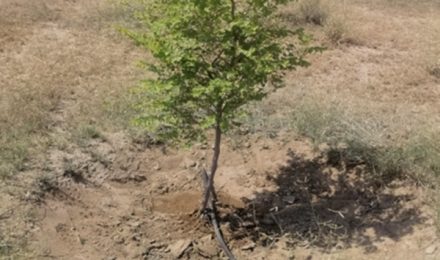
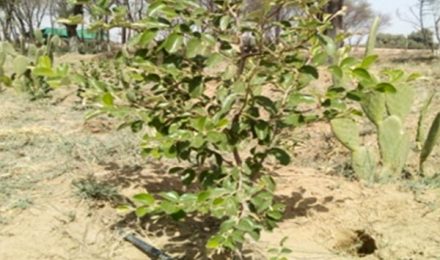
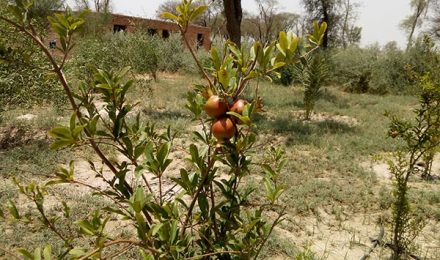
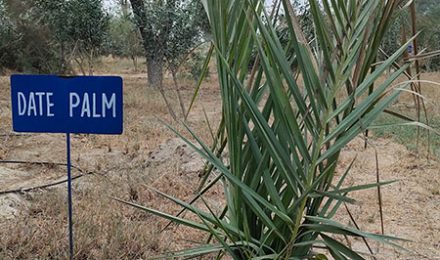
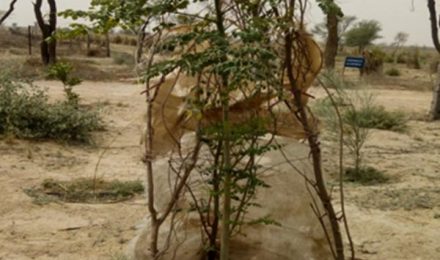
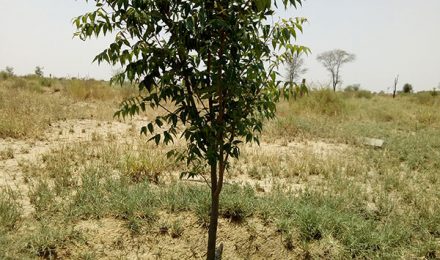
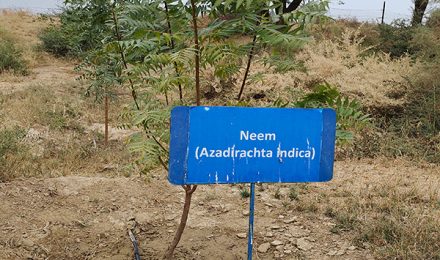
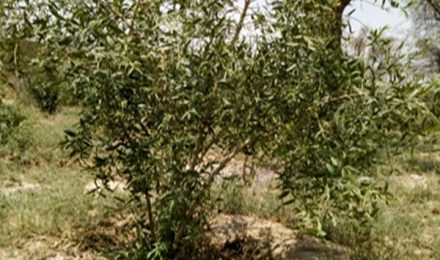
C. FUEL PLANTS
i. DESI KIKAR (Accacianilotica):- This is a medium sized, thorny, nearly ever green tree that can reach a height of 20 – 25 meters. Desi kikar is popular as agroforestry tree. This is a multi purpose tree, widely used as timber, source of fodder for camels, goats and sheep, as a fence, shed and fuel tree. At Field Research Station Dingarh, 200 Nos desi kikar were transplanted. Conjunctive use of irrigation water (rainwater collected in pond and ground saline water) is being used for irrigation
ii. PARKINSONIA (Parkinsonia aculeata):- Parkinsoia is a small evergreen spiny tree and can grow in any soil. It is used for fire wood, leaves and pods used as fodder for goats and sheeps, it is a source of shed in desert environment. It is useful in soil stabilization as a wind break and erosion control and reforestation in sandy areas. 200 No. nursery plants of parkinsonia transplanted in the experimental area.
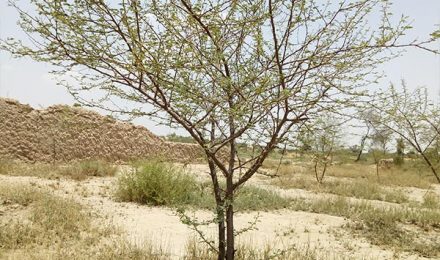
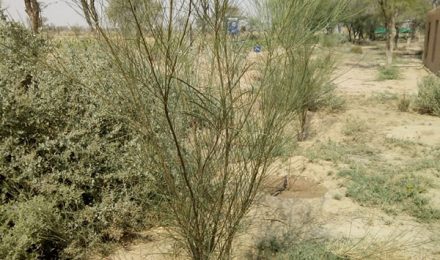
Cactus Plantation
Cactus is becoming a profitable agriculture enterprise in the field of agriculture sector. It is xerophytic plant that has the ability to survive in water scarcity conditions. It acts as a good source of food for humans, edible part of both fruit and modified stem. Keeping in view the importance, about one thousand pads have been planted on one acre dry barren land at Field Research Station Din Garh to test the growth in harsh climatic conditions of Cholistan Desert.

Nursery Development
Nursery of various plant species is being developed at Field Research Station Dingarh for further propagation in field area. In this context seeds of Moringa oliefera 200 Nos. desi beri (Zizyphusjujuba) 300 Nos., desi kikar (Acacia nilotica) 400 Nos., Jand (Prosopis specigena) 200 Nos., karir (Capparis decidas) 100 Nos., atriplex (salt bush) 250 Nos., Neem (Azadirachtaindica) 300 Nos. sown in polyethylene bags, while cuttings of phog(Calligonumpolygonoides) 200 Nos. and frash (tamarix) 200 Nos. also planted in polyethylene bags for the development of nursery of these plants.




